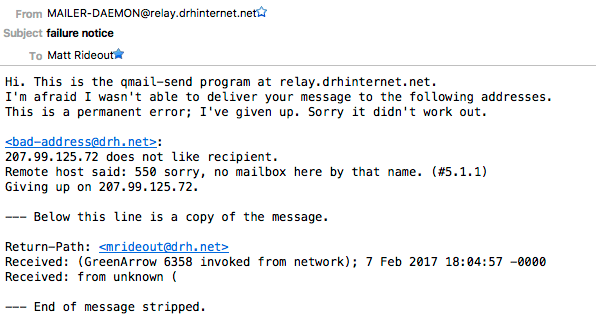
What Is a Bounce Processor, and Why Does It Matter?
I love eggs.
Fried, scrambled, poached, or boiled, they’re one of my favorite foods. But as we all know, eggs are fragile, and not every egg makes it to the table (or even to the frying pan).
In the same way, not every email makes it through to its recipient. Lots of things can go wrong: the recipient’s email address may be entered incorrectly, the ISP that hosts the email account could be having technical issues, or a spam filter could be blocking the message from getting through.
When an egg breaks, we get alerted by broken eggshells and raw egg all over the place. But when an email can’t be delivered, we get something much better: a reply email that informs us why our message couldn’t be delivered. This reply is known as a bounce message.
Humans, Step Aside (Rise of the Bounce Processors)
While bounce messages aren’t sent 100% of the time (spam filters, in particular, may block a message without informing the sender), they are nevertheless indispensable to good deliverability. For example, if you send an email to a friend and mistype their address, you’ll likely see something like this:
 In this case, it’s easy to see what went wrong. But manually reviewing individual bounce messages only scales so far. The good news is that you don’t have to resolve all those bounces yourself because a piece of software called a bounce processor can do it for you.
In this case, it’s easy to see what went wrong. But manually reviewing individual bounce messages only scales so far. The good news is that you don’t have to resolve all those bounces yourself because a piece of software called a bounce processor can do it for you.
Bounce processors vary in complexity and depth of features, but their first task is to collect data from the bounce message itself. This usually includes:
- The original email address that was sent to
- Which campaign, autoresponder or other grouping of emails the original email was a part of
- What mailing list the bounced email address is on
- Why the email bounced
- Whether the email address should be marked as bad. As we’ll see in this post, this decision is influenced by why the email bounced, but other factors like whether this is the first time that the email address bounced can come into play.
What happens next depends on your particular software. A good bounce processor (like GreenArrow’s) will generate detailed stats and deactivate any bad email addresses that it identifies.
Why Bother with Bounce Processing?
Now you may be wondering, “Is all this bounce processing stuff really necessary? Can’t I just send my emails out and ignore the bounces?” Technically yes, you could. But that option comes with some serious downsides.
First and most obviously, sending to bad addresses is a waste of resources because no one is going to receive the emails. Every email sent to a bad address is cluttering up your send queue and getting in the way of the real recipients of your email.
Second, sending to bad addresses reduces your click and open rates. This is also a no-brainer. If an email is sent to a forest and no one reads it, was it really sent? Absolutely it was. And it makes your marketing team look bad because it’s dragging your click and open rates down into the dirt.
But the real danger in refusing to process your bounces is that you could be marked as a spammer. Many ISPs and spam filtering services look at the sender’s bounce rate (percentage of emails that bounce) when deciding whether to deliver their emails to the Inbox or the Spam folder. High bounce rates are strongly correlated with spam, so each bounced message you ignore is hurting your deliverability.
Additionally, a bad email address does not always stay a bad email address — but is sometimes turned into a “spam trap”, often after bouncing for a period of time, like six months. This is a technique used by mailbox providers and spam filters to catch senders who don’t do bounce processing or send to old email lists. Sending to these spam traps can get you marked as a spammer. (You can learn more about spam traps in our Email Spam Traps and Honey Pots Explained blog post.)
Hard Bounce, Soft Bounce, or… Over Easy?
As much as I love eating eggs, I have no idea which of the eggs in the image above are hard boiled, soft boiled, or raw. I would need to crack each of them open to find out.
In the same way, bounce messages also exist in one of three states: “hard,” “soft,” or “other.” Unfortunately, the email industry as a whole isn’t very consistent when it comes to defining what each of these means, so for the sake of consistency, we’ll use GreenArrow’s definitions of the terms.
Hard Bounces
A hard bounce occurs when the bounce text contains information indicating the email address is “bad” (i.e., it no longer exists). For example, if you send an email to a fake address like [email protected], you’ll receive a hard bounce reply that looks something like this:
<[email protected]>:
207.99.1125.72 does not like recipient.
Remote host said: 550 sorry, no mailbox here by that name. (#5.1.1)
Giving up on 207.99.125.72.
The key part of the bounce text is the portion that reads “no mailbox here by that name.” Straightforward enough for even my great grandmom to understand—time to stop sending to that address.
Soft Bounces
Soft bounces are more complex, and thus require more finesse to process efficiently. A soft bounce occurs when the bounce text contains information that suggests that the email might be bad, but with less than 100% certainty. As you can imagine, there are a lot of potential bounce messages that fit that description, so a good bounce processor has multiple classifications that it can use when processing a soft bounce.
Here are a few examples showing the original bounce text, and how GreenArrow’s bounce processor classifies them:
| Original Bounce Text | GreenArrow Classification |
|
<[email protected]>: |
General Soft Bounce |
|
<[email protected]>: |
DNS Failure Soft Bounce |
|
The user(s) account is temporarily over quota. |
Mailbox Full Soft Bounce |
Other Bounces
An “Other” bounce is any bounce that indicates that the email couldn’t be delivered, but which does not contain any information indicating that the email address itself is bad. For example, the table below shows three different types of “Other” bounces, along with the corresponding GreenArrow classification:
| Original Bounce Text | GreenArrow Classification |
|
<[email protected]>: Connected to 64.136.44.37 but greeting failed. Remote host said: 550 Access denied…05e702ef9fefcece579713f7aa5eaa971… |
Mail block – General Other Bounce |
|
<[email protected]>: 208.65.145.3 failed after I sent the message. Remote host said: 553 Sender is on user denylist (Mode: normal) |
Mail block – Known Spammer Other Bounce |
|
<[email protected]>: 66.193.136.233 failed after I sent the message. Remote host said: 554 5.7.1 This email has been rejected. The email message was detected as spam. |
Mail block – Spam Detected Other Bounce |
Deactivating Subscribers Is Such Sweet Sorrow
Suppose you receive a bounce message (either hard, soft or other). When should you keep a subscriber on your list, and when should you bid them ‘adieu?’ That’s where a little industry wisdom goes a long way. GreenArrow’s bounce processor deactivates a subscriber in either of the following conditions:
- An email address hard-bounces once.
- An email address soft-bounces 2 or more consecutive times, spread 10 or more days apart.
By default, GreenArrow does not deactivate subscribers due to other bounces, regardless of how many occur.
As you can see, “Hard” bounce processing and “Other” bounce processing is cut and dry, but “Soft” bounce processing is a bit more nuanced. Let’s look at an example scenario to better illustrate how soft bounces get treated.
Let’s suppose that a subscriber’s email account has been disabled by the ISP. As a result, each time that GreenArrow tries to email that subscriber, the following bounce message gets generated:
<[email protected]>:
209.85.232.26 does not like recipient.
Remote host said: 550-5.2.1 The email account that you tried to reach is disabled. Learn more at 550 5.2.1 https://support.google.com/mail/?p=DisabledUser b65si2656430qkf.245 – gsmtp
Giving up on 209.85.232.26.
It’s not clear whether this deactivation is permanent, so GreenArrow classifies (and records in the campaign stats) these as soft bounces. Let’s further suppose that this subscriber is emailed once per day, and each time the same bounce message comes back. At what point will GreenArrow’s bounce processor deactivate this subscriber?
The answer is on day 11:
| Day | 2 or more consecutive bounces? | 10 or more days apart? |
| 1 |
No |
No |
| 2 | Yes | No |
| 3 | Yes | No |
| 4 | Yes | No |
| 5 | Yes | No |
| 6 | Yes | No |
| 7 | Yes | No |
| 8 | Yes | No |
| 9 | Yes | No |
| 10 |
Yes |
No |
| 11 | Yes | Yes |
Earlier, we mentioned that soft bounces don’t result in a subscriber being deactivated until 2 or more consecutive bounces are spread 10 or more days apart. In other words, all three of these criteria must be met:
- There must be 2 or more soft bounces. (This happens on day 2.)
- The bounces must be consecutive.
- The bounces must be spread out over 10 or more days. (This happens on day 11.)
All three criteria are met on day 11, so on that day, GreenArrow will attempt to deactivate that subscriber. “Deactivating a subscriber” can mean one or more of the following, depending on where the original email came from, and how your server is configured:
- If the email came from GreenArrow’s Marketing Studio, then the subscriber’s status automatically gets set to “Bounced.” This prevents GreenArrow from sending to them again. Marketing Studio may also be configured to add the email address to a suppression list.
- If you’re using the Event Notification System, then GreenArrow uses a webhook or SQL query to let your application know that the subscribers should be deactivated.
- If you’re using Bad Address Suppression, then GreenArrow adds the bad email address to the list of addresses to suppress for future sends.
Time For Us To Bounce
Now that you’ve learned about what bounce processors do and why they’re important, I’d encourage you to take a closer look at your bounce processor (assuming you’re using one). How is it classifying bounces? Does it differentiate between bounces that indicate that an email address is bad and those that don’t?
Here are a few potential launching points for learning more about GreenArrow’s bounce processor:
- If you’re using GreenArrow’s Marketing Studio, this video provides an example of how to view its bounce stats.
- If you’re using GreenArrow Engine without our Marketing Studio, then this video is a good starting point.
- If you prefer written documentation over video, then check out GreenArrow’s Bounce Processor documentation.
If you don’t have a bounce processor, or it’s not doing everything you’d like it to, then it might be time to check out what GreenArrow has to offer. Call us or request your free demo today. In the meantime, happy sending!
Advanced Email Throttling: Three Essential Tools for Sending Success
Ready for the spotlight? Even though I’ve been playing for several years now, I’m still pretty much a novice whose…
Transactional Email Speed: A 30-Day Experiment
Has this ever happened to you? I love aged Sumatran coffee. It’s often marketed as a Christmas blend, so it…